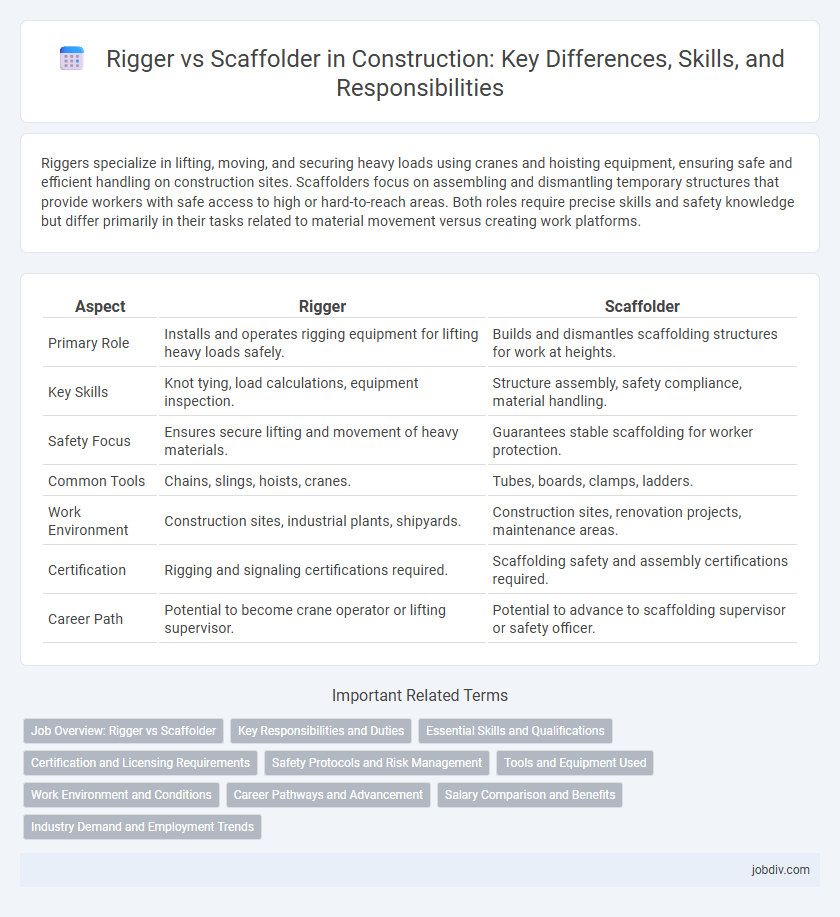Riggers specialize in lifting, moving, and securing heavy loads using cranes and hoisting equipment, ensuring safe and efficient handling on construction sites. Scaffolders focus on assembling and dismantling temporary structures that provide workers with safe access to high or hard-to-reach areas. Both roles require precise skills and safety knowledge but differ primarily in their tasks related to material movement versus creating work platforms.
Table of Comparison
| Aspect | Rigger | Scaffolder |
|---|---|---|
| Primary Role | Installs and operates rigging equipment for lifting heavy loads safely. | Builds and dismantles scaffolding structures for work at heights. |
| Key Skills | Knot tying, load calculations, equipment inspection. | Structure assembly, safety compliance, material handling. |
| Safety Focus | Ensures secure lifting and movement of heavy materials. | Guarantees stable scaffolding for worker protection. |
| Common Tools | Chains, slings, hoists, cranes. | Tubes, boards, clamps, ladders. |
| Work Environment | Construction sites, industrial plants, shipyards. | Construction sites, renovation projects, maintenance areas. |
| Certification | Rigging and signaling certifications required. | Scaffolding safety and assembly certifications required. |
| Career Path | Potential to become crane operator or lifting supervisor. | Potential to advance to scaffolding supervisor or safety officer. |
Job Overview: Rigger vs Scaffolder
Riggers specialize in lifting, securing, and moving heavy materials using cranes, hoists, and other rigging equipment, ensuring safe load handling on construction sites. Scaffolders focus on assembling, maintaining, and dismantling temporary structures that provide safe work platforms for construction workers at various heights. Both roles require knowledge of safety standards and structural integrity but differ significantly in their primary tasks and equipment expertise.
Key Responsibilities and Duties
Riggers are responsible for securing, lifting, and moving heavy materials using cranes, hoists, and other lifting equipment, ensuring load stability and safety compliance on construction sites. Scaffolders specialize in erecting, assembling, and dismantling scaffolding structures that provide safe access and working platforms for construction crews at various heights. Both roles require adherence to strict safety regulations, with riggers focusing on load management and scaffolders prioritizing structural integrity and worker safety.
Essential Skills and Qualifications
Riggers require expertise in load calculations, crane operations, and signal communication to ensure safe material handling on construction sites. Scaffolders must have skills in erecting, modifying, and dismantling scaffolding structures while complying with safety regulations and using personal protective equipment. Both roles demand physical strength, attention to detail, and certifications such as OSHA training or equivalent safety credentials.
Certification and Licensing Requirements
Riggers and scaffolders require distinct certification and licensing to ensure safety and compliance with construction regulations. Riggers must typically obtain certifications such as the NCCCO Crane Rigger Certification, demonstrating proficiency in load handling and crane signaling, while scaffolders often need OSHA scaffold user and erector certifications to verify competence in assembling and dismantling scaffolding systems. Both roles demand adherence to local and national safety standards, with certification validity often contingent on periodic renewals and continuing education.
Safety Protocols and Risk Management
Riggers and scaffolders each follow stringent safety protocols tailored to their roles, with riggers emphasizing secure hoisting techniques and load stability to prevent equipment failure and accidents. Scaffolders prioritize structural integrity and safe assembly of platforms, implementing guardrails, toe boards, and regular inspections to mitigate fall hazards. Both professions conduct risk assessments and adhere to OSHA standards to ensure comprehensive hazard identification and worker protection on construction sites.
Tools and Equipment Used
Riggers commonly use tools such as shackles, wire ropes, slings, and hoists to lift and secure heavy loads in construction sites, ensuring safe and precise handling of materials. Scaffolders rely on equipment like steel poles, couplers, planks, and base plates to assemble sturdy and stable scaffolding structures that provide safe working platforms at various heights. Both professions require the use of safety harnesses, helmets, and protective gloves to comply with industry safety standards.
Work Environment and Conditions
Riggers operate in dynamic, often high-risk environments such as construction sites with heavy machinery and elevated work areas, requiring precise coordination to safely lift and move loads. Scaffolders work primarily at various heights, constructing and dismantling temporary frameworks in exposure to weather conditions and potential fall hazards. Both roles demand adherence to strict safety protocols and physical endurance to manage challenging onsite conditions.
Career Pathways and Advancement
Riggers and scaffolders both play critical roles in the construction industry, with distinct career pathways that offer advancement opportunities through specialized training and certifications. Riggers often progress from entry-level positions to become lead riggers or supervisors by mastering complex load handling and crane signaling techniques. Scaffolders can advance to foreman or site manager roles by gaining expertise in scaffold design, safety compliance, and large-scale project coordination, making both careers viable for long-term growth.
Salary Comparison and Benefits
Riggers typically earn a median salary range of $45,000 to $65,000 annually, with benefits including health insurance, retirement plans, and overtime pay, reflecting their specialized skills in heavy equipment and load management. Scaffolders earn slightly less, averaging between $40,000 and $60,000 per year, with benefits focused on health coverage and safety training due to the physical risks associated with scaffold erection and maintenance. Both professions offer job stability and union membership options, which can significantly enhance wage growth and access to comprehensive benefits packages.
Industry Demand and Employment Trends
Riggers and scaffolders both face robust industry demand driven by infrastructure projects and urban development, with scaffolders experiencing higher employment growth due to increased safety regulations and temporary access needs. According to the U.S. Bureau of Labor Statistics, scaffolders are projected to see a 6% employment increase from 2022 to 2032, reflecting sustained construction activity and renovation efforts. Riggers remain essential in sectors like heavy lifting and oil and gas, ensuring steady demand, but their growth rate is comparatively moderate amid automation advances.
Rigger vs Scaffolder Infographic

 jobdiv.com
jobdiv.com